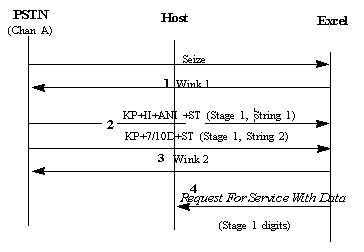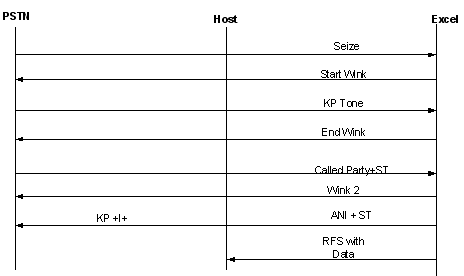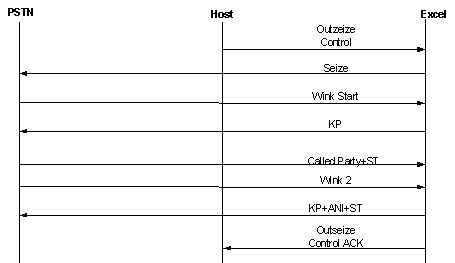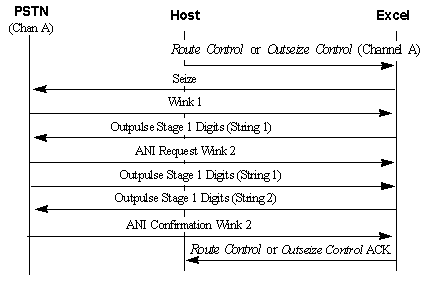
You are here: CSP Developerís Guide: Line Cards†>†2 T1 Information†>†T1 Call Flows

This section includes call flows for T1 interfaces.
Inbound Four-digit DNIS
The example call comes into the CSP with E&M Wink Start signaling. The channel has been configured using the Inpulsing Parameters Configure message, with the following inpulsing parameters:
|
Number of Stages: |
1 |
|
Number of Digit Strings: |
1 |
|
Address Signaling Type: |
DTMF |
|
Stage Complete Timeout: |
20 seconds |
|
String Collection Method: |
Fixed Number of Digits |
|
Number of Digits: |
4 |
The channel has been previously configured using the Inseize Instruction List Configure message with the following inseize instruction list:
1. Generate Inseize ACK (Wink 1)
2. Receive Stage 1 Digits
3. Report Incoming Call with Address Data
4. Wait for Host Control
When an incoming call is detected, the CSP performs the following steps:
1. Generates Wink 1
2. Performs in-band DTMF reception, collecting and storing four Stage 1 digits
3. Reports the incoming call with the Stage 1 digit buffer and channel ID in a Request for Service with Data message sent to the host
4. Waits for further instructions from the host

Inbound - Exchange Access North American (EANA)
The example call comes into the CSP with E&M Wink Start signaling. The channel is configured with the following inpulsing parameters (using the Inpulsing Parameters Configure message):
|
Number of Stages: |
1 |
|
Number of Digit Strings: |
2 |
|
Address Signaling Type: |
MFR1 |
|
Stage Complete Timeout: |
20 seconds |
|
String Collection Method: |
KP/ST Framed |
The channel has been previously configured with the following inseize instruction list (using the Inseize Instruction List Configure message):
1. Generate Inseize ACK (Wink 1)
2. Receive Stage 1 Digits
3. Generate Wink 2
4. Report Incoming Call with Address Data
5. Wait for Host Control
When an incoming call is detected, the CSP performs the following:
1. Generates Wink 1
2. Performs in-band MFR1 reception, collecting and storing the KP/ST framed ANI digits and the called party address in Stage 1
3. Generates an ANI confirmation Wink 2
4. Reports the incoming call with the Stage 1 digit buffer and channel ID in a Request For Service With Data message sent to the host
5. Waits for further instructions from the host

Inbound - Taiwan MDR1 with ANI
The example call comes into the CSP with E&M Wink Start signaling. The channel is configured with the following inpulsing parameters (using the Inpulsing Parameters Configure message):
|
Number of Stages: |
2 |
|
Number of Digit Strings: |
1 |
|
Address Signaling Type: |
MFR1 |
|
Stage 1 Complete Timeout: |
20 seconds |
|
Stage 1 String 1 Collection Method: |
KP/ST Compelled |
|
Stage 2 Complete Timeout |
20 seconds |
|
Stage 2 String 1 |
KP/ST framed |
The channel has been previously configured with the following inseize instruction list (using the Inseize Instruction List Configure message):
1. Generate Inseize ACK (Wink 1).
2. Receive Stage 1 Digits.
3. Generate Wink 2.
4. Receive Stage 2 Digits.
5. Report Incoming Call.
6. Wait for Host Control.
7. Set the following timers:
PPL Timer 0x5B - 640 ms
PPL Timer 0x1D - 800 ms
When an incoming call is detected, the CSP performs the following:
1. Starts Wink 1. Waits to detect KP Tone. Acknowledges KP tone by ending wink.
2. Performs in-band MFR1 reception, collecting and storing the KP/ST 1 framed digits and the called party address in Stage 1
3. Generates an ANI request Wink 2
4. Performs in band MFR1 reception, collecting and storing the KP/ST 1 framed ANI digits in Stage 2.
5. Reports with Stage 1 and Stage 2 digit buffer and channel ID in a Request for Service with Data message sent to the host.
6. Waits for further instructions from the host.

The example call shows the host instructing the CSP to initiate an outbound call with E&M Wink Start signaling. Using the Outseize Control message, the host can have varying degrees of interaction with the CSP. The host can send each instruction separately, use a list of instructions preprogrammed on a channel with the Outseize Instruction List Configure message, or a combination of both.
To process this call without preprogrammed instructions, send a Route Control (or Outseize Control) message with the following ICBs:
1. Action ICB: Seize
2. Action ICB: Outpulse Stage 1
3. Action ICB: Send Host ACK
4. Action ICB: Wait for Host Control with Answer Supervision
5. Data ICB: Stage 1 Digits (DTMF digits, 4)
To process this call using preprogrammed instructions, send a Route Control (or Outseize Control) message with the following ICBs:
1. Action ICB: Seize
2. Action ICB: Use Instruction List
The CSP initiates the channelís outseize instruction list, previously configured with the Outseize Instruction List Configure message.
Outpulse Stage 1 (the CSP uses the first Data ICB in list 3)
ē Send Host ACK
ē Wait for Host Control with Answer Supervision
3. Data ICB: Stage 1 Digits (DTMF digits, 4)

Outbound - Exchange Access North American (EANA)
To process this call without preprogrammed instructions, send a Route Control (or Outseize Control) message with the following ICBs:
Route Control message
1. Action ICB: Seize
2. Action ICB: Outpulse Stage 1 Digits
3. Action ICB: Scan For Wink 2
4. Action ICB: Send Host ACK
5. Action ICB: Wait for Host Control with Answer Supervision
6. Data ICB: Stage 1 Digits To Be Outpulsed (String1: ANI, String 2: MFR1 Called Party Address)
To process this call using preprogrammed instructions, the host first configures the channel with the following instructions:
Outseize Instruction List
1. Outpulse Stage 1 Digits
2. Scan For Wink 2
3. Send Host ACK
4. Wait for Host Control with Answer Supervision
Then, the host sends a Route Control (or Outseize Control) message with the following ICBs:
1. Action ICB: Seize
2. Action ICB: Use Instruction List
3. Data ICB: Stage 1 Digits (String1: ANI, String 2: MFR1 Called Party Address

Outbound - Taiwan MDR1 with ANI
To process this call without preprogrammed instructions, send a Route Control (or Outseize Control) message with the following ICBs:
Route Control message
1. Action ICB: Seize
2. Action ICB: Outpulse Stage 1 Digits
3. Action ICB: Scan For Wink 2
4. Outpulse Stage 2 Digits.
5. Action ICB: Send host ACK.
6. Action ICB: Wait for Host Control with Answer Supervision
7. Data ICB: Stage 1 Digits To Be Outpulsed (String1: KP Compelled MFR1.
8. Data ICB Stage 2 Digits to be outpulsed (String 1: MFRI (0x04) must use ST 1 as last signal.)

Outbound - Exchange Access International (EAI)
To process this call without preprogrammed instructions, send a Route Control (or Outseize Control) message with the following ICBs:
1. Action ICB: Seize
2. Action ICB: Outpulse Stage 1 Digits
3. Action ICB: Scan For Wink 2
4. Action ICB: Outpulse Stage 2 Digits
5. Action ICB: Scan For Wink 3
6. Action ICB: Send Host ACK
7. Action ICB: Wait for Host Control with Answer Supervision
8. Data ICB: Stage 1 Digits (String1: country routing information)
9. Data ICB: Stage 2 Digits (String 1: ANI, String 2: MFR1 Called Party Address)
To process this call using preprogrammed instructions with the Outseize Instructions List Configure message, the host first configures the channel with the following instruction list:
1. Outpulse Stage 1 Digits
2. Scan For Wink 2
3. Outpulse Stage 2 Digits
4. Scan For Wink 3
5. Send Host ACK
6. Wait for Host Control with Answer Supervision
Then send a Route Control message with the following ICBs:
1. Action ICB: Seize
2. Action ICB: Use Instruction List
3. Data ICB: Stage 1 Digits (String1: country routing information)
4. Data ICB: Stage 2 Digits (String 1: ANI, String 2: MFR1 Called Party Address)
